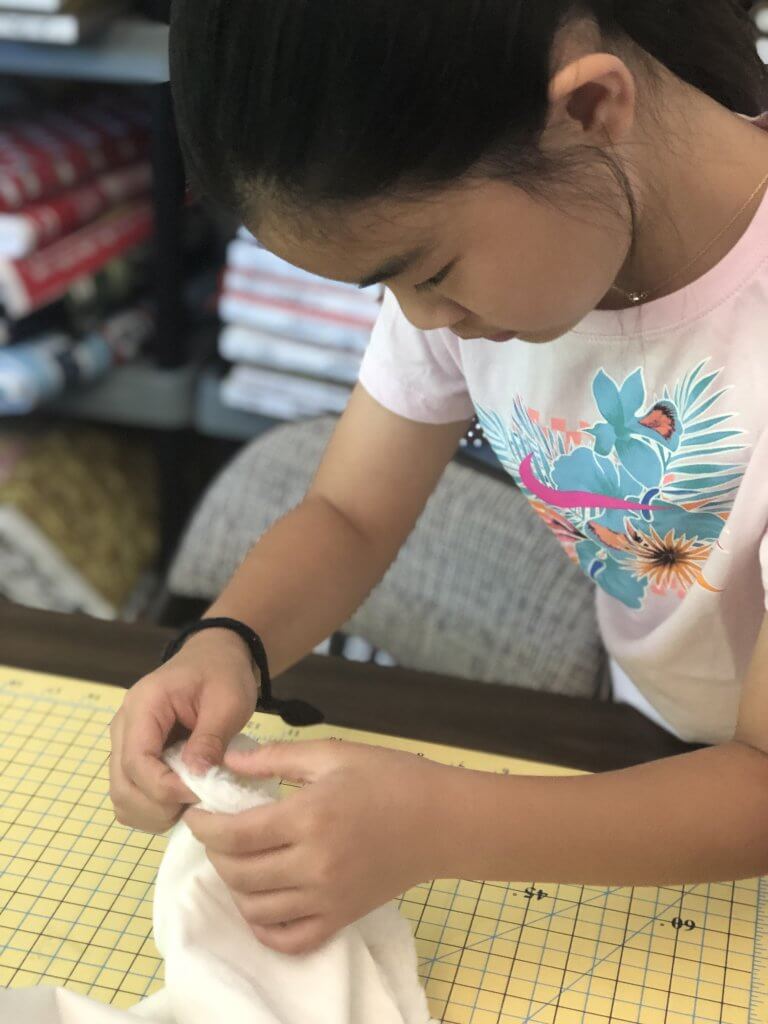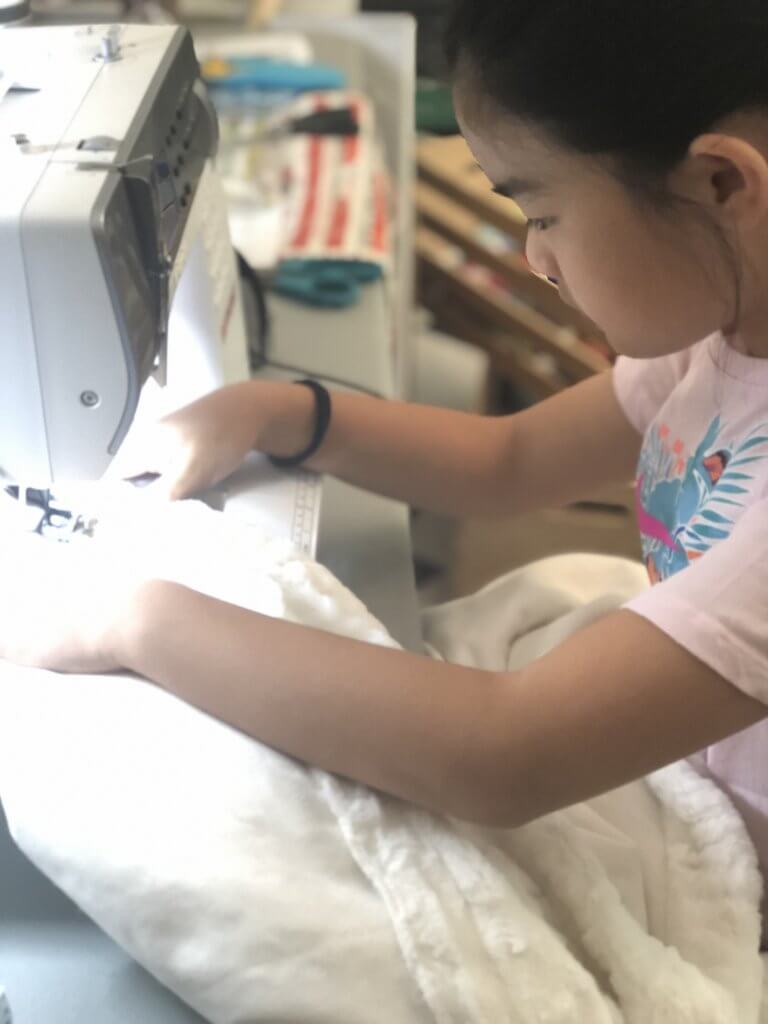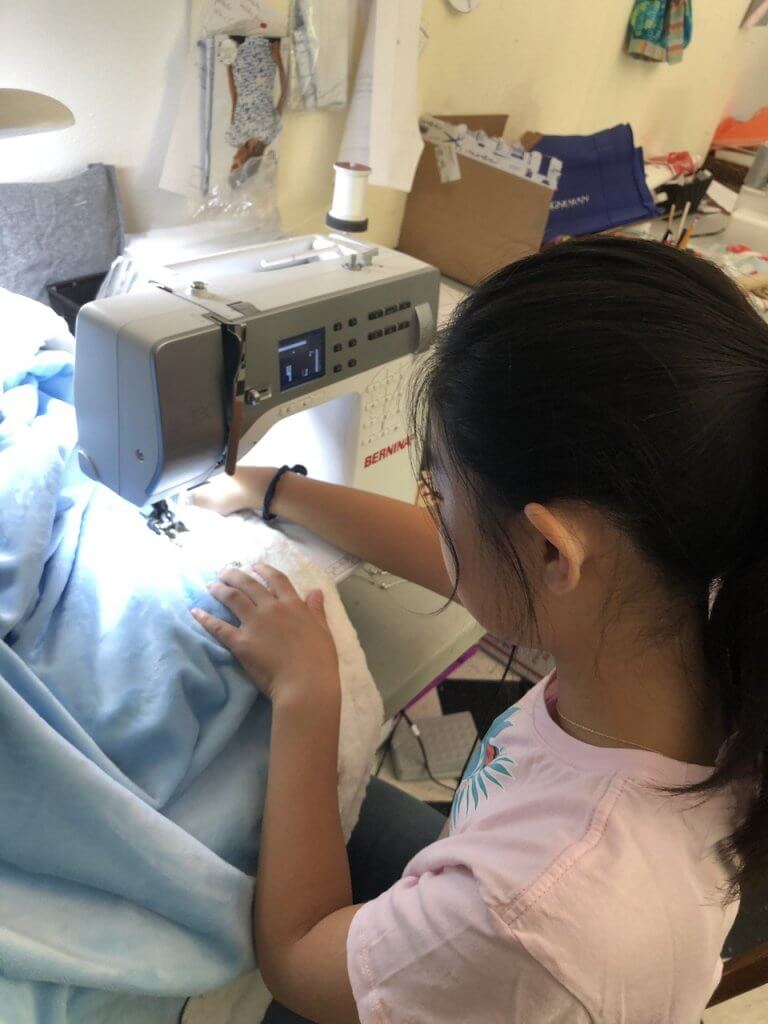I have been doing a lot of teaching these days. That’s how it goes in the summer. I tend to do one on one teaching of children for several reasons. For one, I like to give them undivided attention. Where hot irons and sewing machines are concerned, you have to watch them like a hawk. Secondly, when I advertise classes for children at particular times, hoping to get 2 or 3 kids at a time, it never works. Kids get so hyper scheduled in the summer that it is difficult for parents to get them to the shop on my time, I have to be on their time. And, that is fine. My shop doesn’t move, it’s always there, and right now, it’s my primary job. I am no longer working as a nurse, but sometimes I am babysitting my grandbabies.
This summer I have been posting pictures of a little girl that I have been teaching.

She’s smart as a whip. But, most of the children that I teach are pretty smart. They catch on quickly.
I am not a certified teacher. I was trained with a bachelor’s in science as a Registered Nurse. However, I have been sewing my entire life, and have been fortunate enough to have excellent 4-H leaders teaching me the correct way to sew.
I want to be able to teach young people the right way to sew. It makes me sad to hear so many sewists say that they were self taught, and they learned on you-tube.
So, let’s talk about what I have learned both as a student and an instructor when teaching children to sew.
Here are my dos and don’ts.
- First and foremost of the utmost importance is this–don’t lecture before sitting them at the sewing machine or letting them cut. Do this while you are teaching. A young student will expect to sew or cut or both on day 1. They won’t want to come back if all you have done the entire time is lecture them. Talk to them about straight of grain as you are pinning the pattern on the fabric. Talk to them about cutting around notches as they are pinning the fabric and cutting. Talk to them about warp and weft, knit vs. woven, and the variety of types of fabrics when they are picking out their fabric. Never stand in front and lecture them without them being active.
- Choose a time before they come to your house for the first class to pick out their project. Have 1 or 2 samples of things that they can sew and let them choose. Make sure it is a relevant project, not something that is out of style, or something they will never use. Sometimes parents have an idea of what they want the child to make. You can gently tell the parent that they can make suggestions, but the ultimate expression of creativity should come from the child. You can either get the supplies for the child or let the parents get them. Be specific with the list of supplies!
- Teach safety but do it while they are working on their project. It’s important to teach about a hot iron, but do it while they are using the iron. They’ll remember it better this way. This is related to point #1, but safety should always be done right away, up front.
- Allow frequent breaks for a snack, bathroom, or for them to tell you what happened that day or during the week. It may cut into class time, but kids like to talk about themselves and should be allowed to do so. This will also allow you to get to know them better. Make sure though, that you redirect because if the parent gets back at the end of the hour and nothing has been done, they will have a right to be upset.

- Here’s an important one–be careful about not making the child rip! If there’s a mistake that does not affect the overall construction or fit, leave it alone. I know this sounds wrong, but trust me, it’s not. If the mistake is one that can be tolerated and won’t alter the fit or won’t make a huge difference in the end let it go. But, you should address the mistake, point out how and why it’s a mistake, and then they will know for the next time. If they make the same mistake next time, then you can decide if it’s important enough to make them take it out, but make sure to point out the fact that they have made this mistake before, in a nonjudgemental way. Nothing kills enthusiasm faster than an instructor that is anal retentive and can’t let any little mistake go. The child will not only hate sewing but won’t like you much either. My mother was a master at letting us experiment with the sewing machine. She would point out our mistakes, and then tell us that we needed to decide if we could live with that mistake or not. As a result, I am kind of liberal with my own mistakes even to this day. I don’t allow something to look sloppy bad–ever. But, I don’t want to take the joy out of sewing for me or someone else.
- Don’t schedule the learning session after school. They won’t sit still.
- Find out in advance if the child is left or right handed. It will make a difference with scissors and how you set up the sewing area.
This is not by any means an exhaustive list. Be aware that you will be helping with hands on. Have realistic expectations, and when you do the child usually exceeds them. Most importantly, make it fun. Put on some fun music, and make sure to keep it light. You definitely want them coming back!


